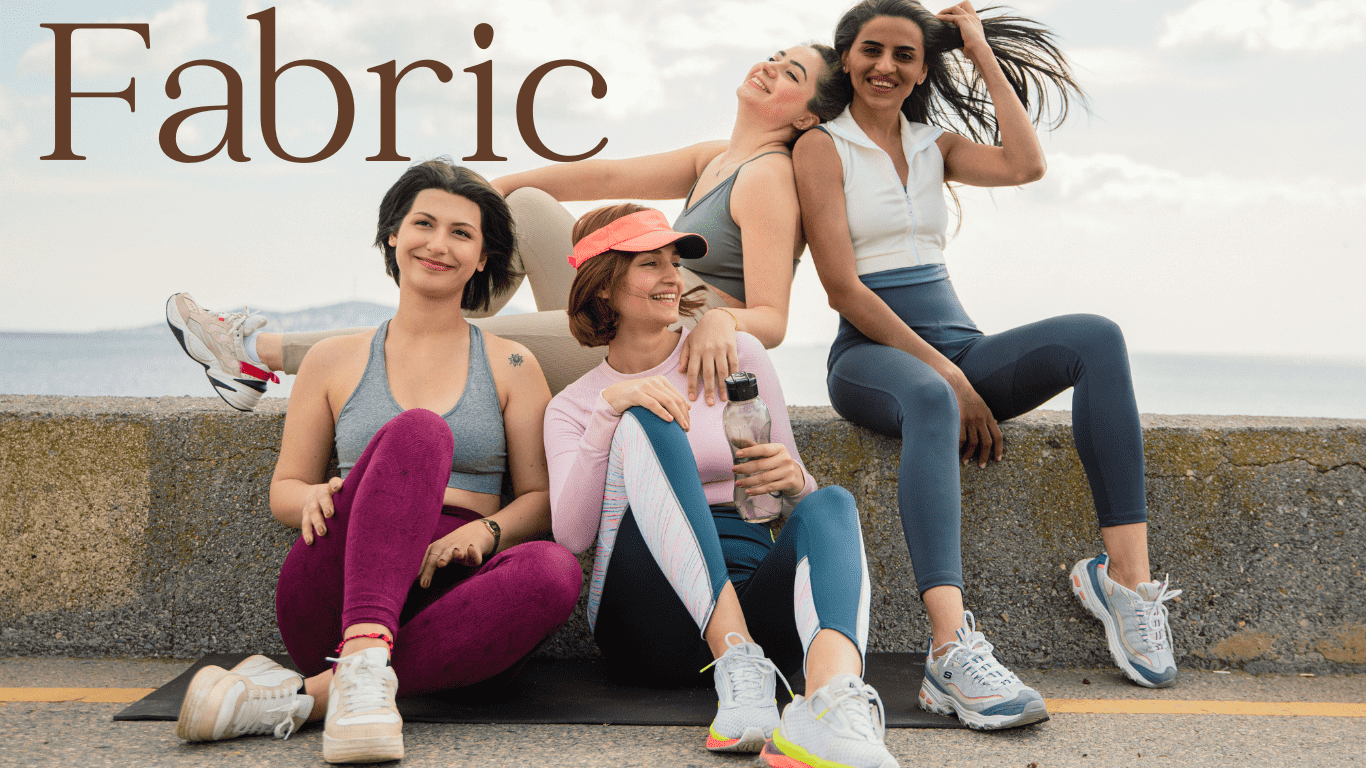
We offer a wide range of activewear fabrics and are always adding new styles based on current trends. All fabrics are tested by us for quality, resulting in luxurious sports products. This page shows our main fabric ranges, we have many more options to choose from.Please contact us for detailed inquiries on other fabrics.
Content
1.Low intensity--Yoga
2.Med-High Intensity
3.High Intensity
4.Casual Wear
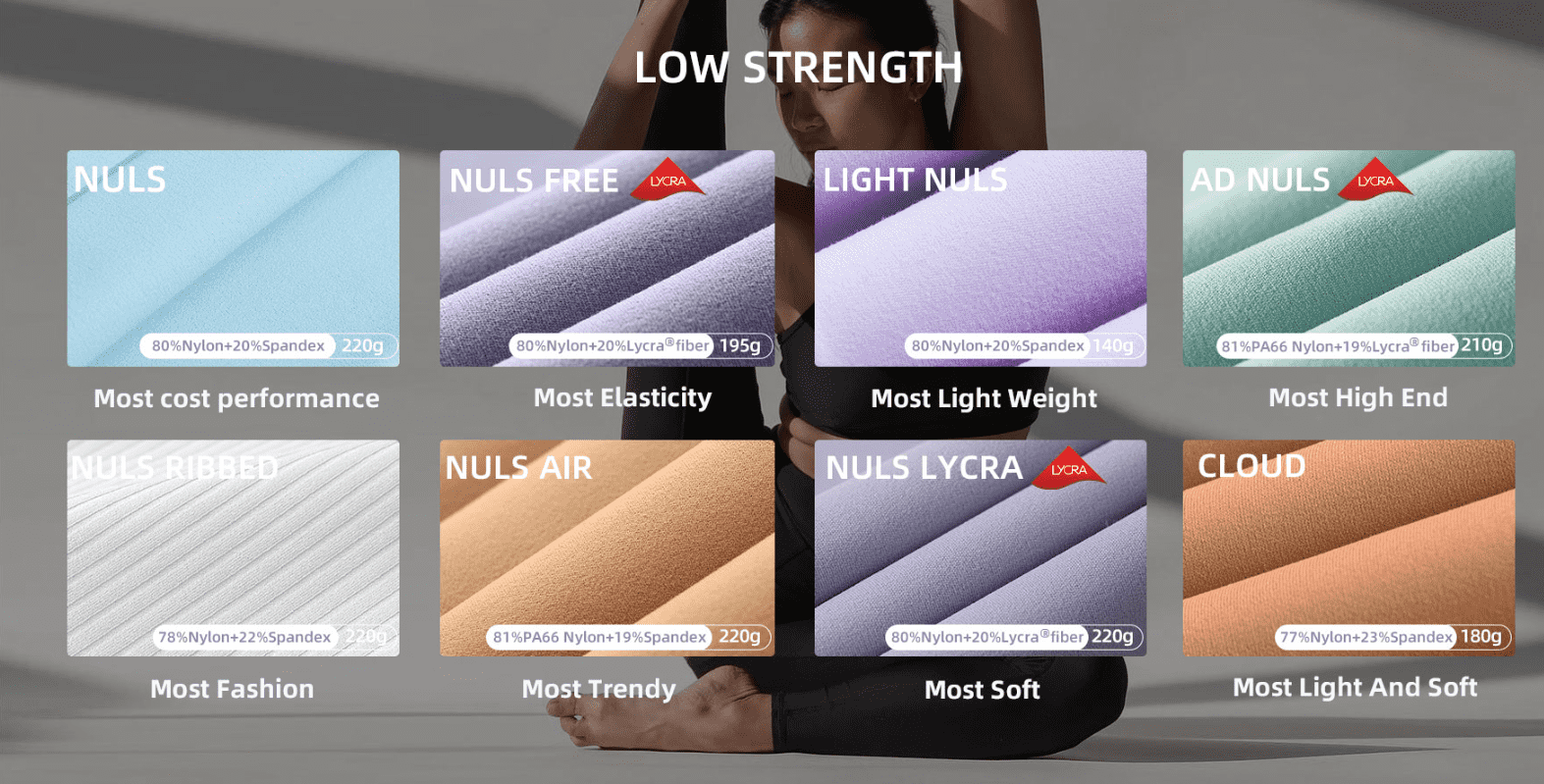
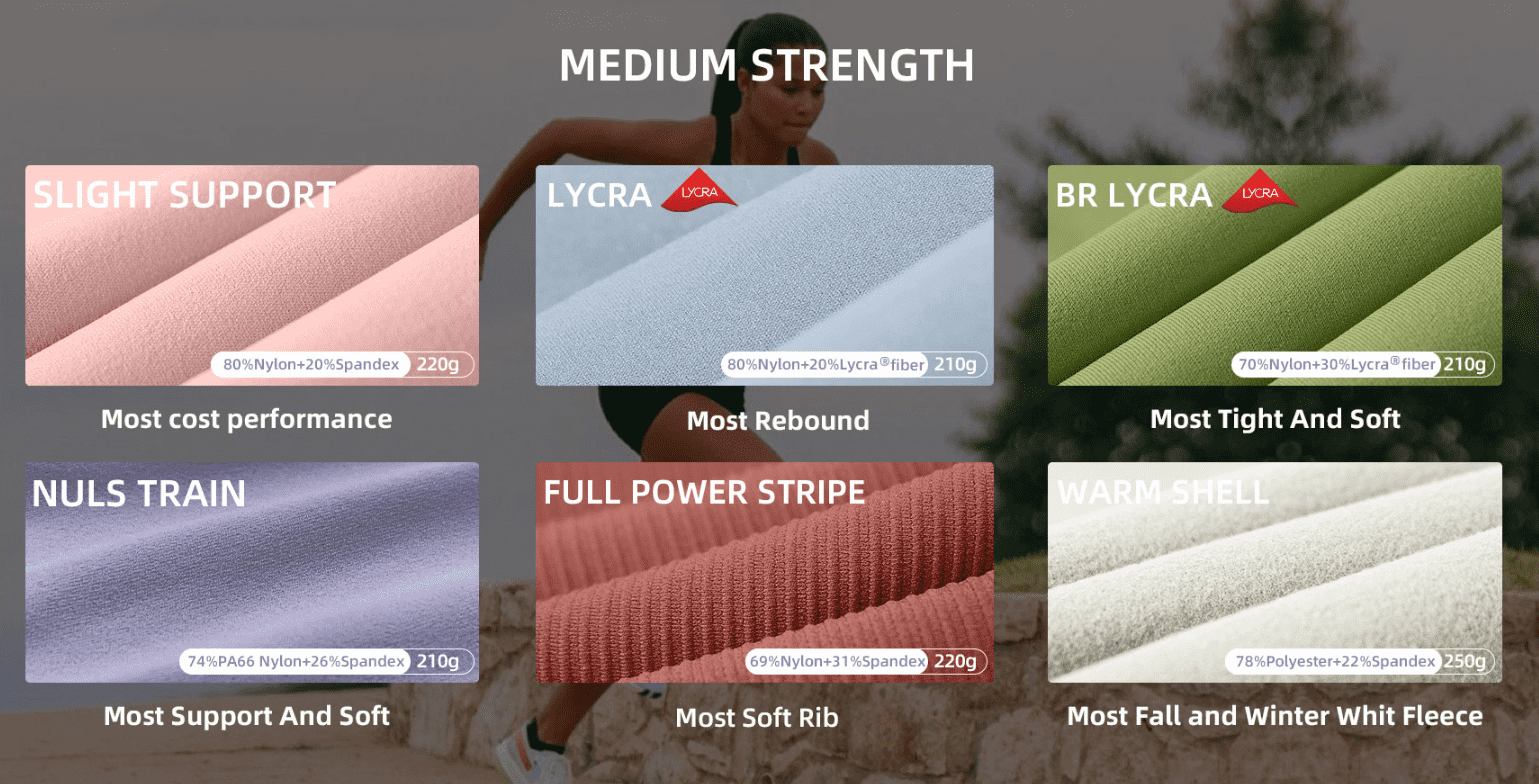
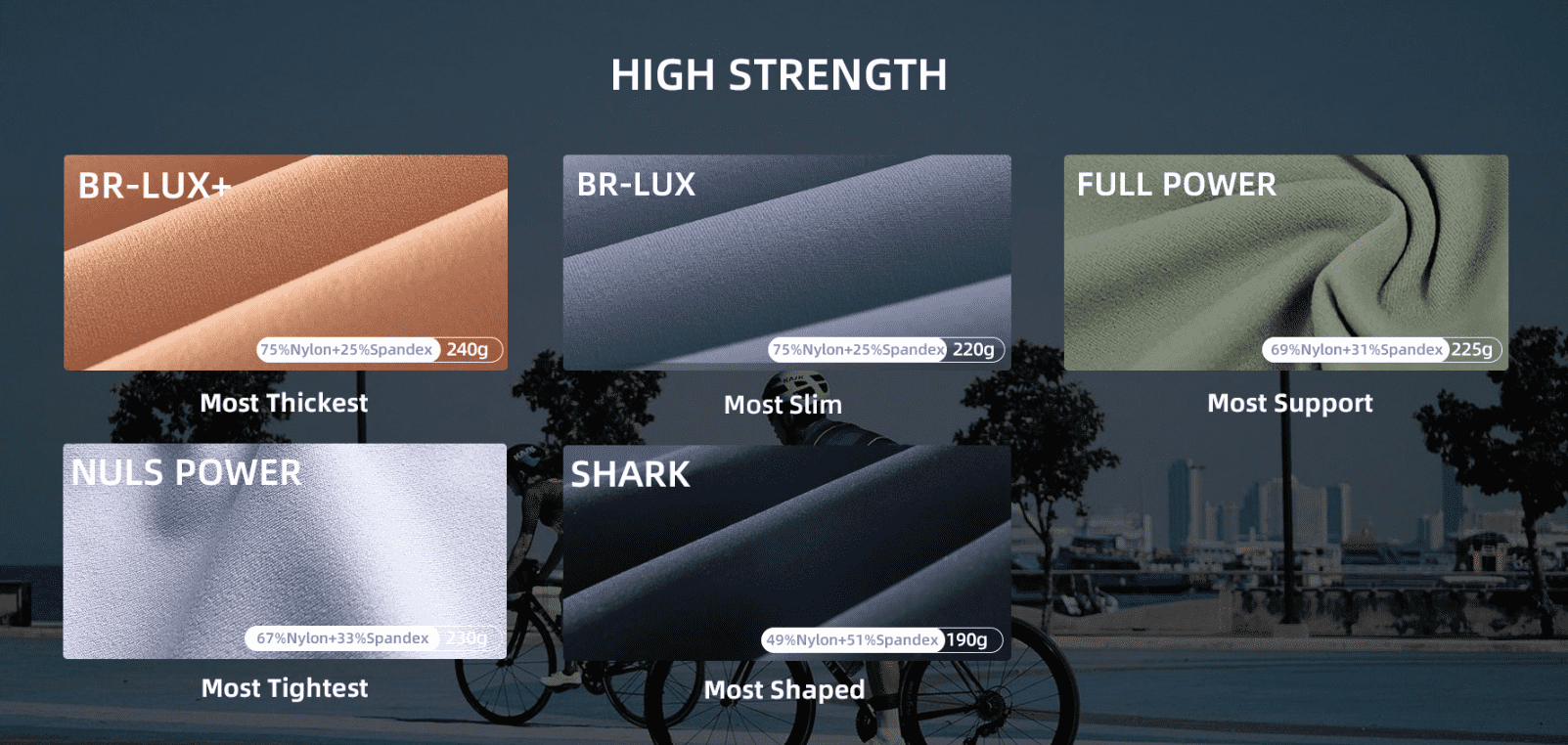
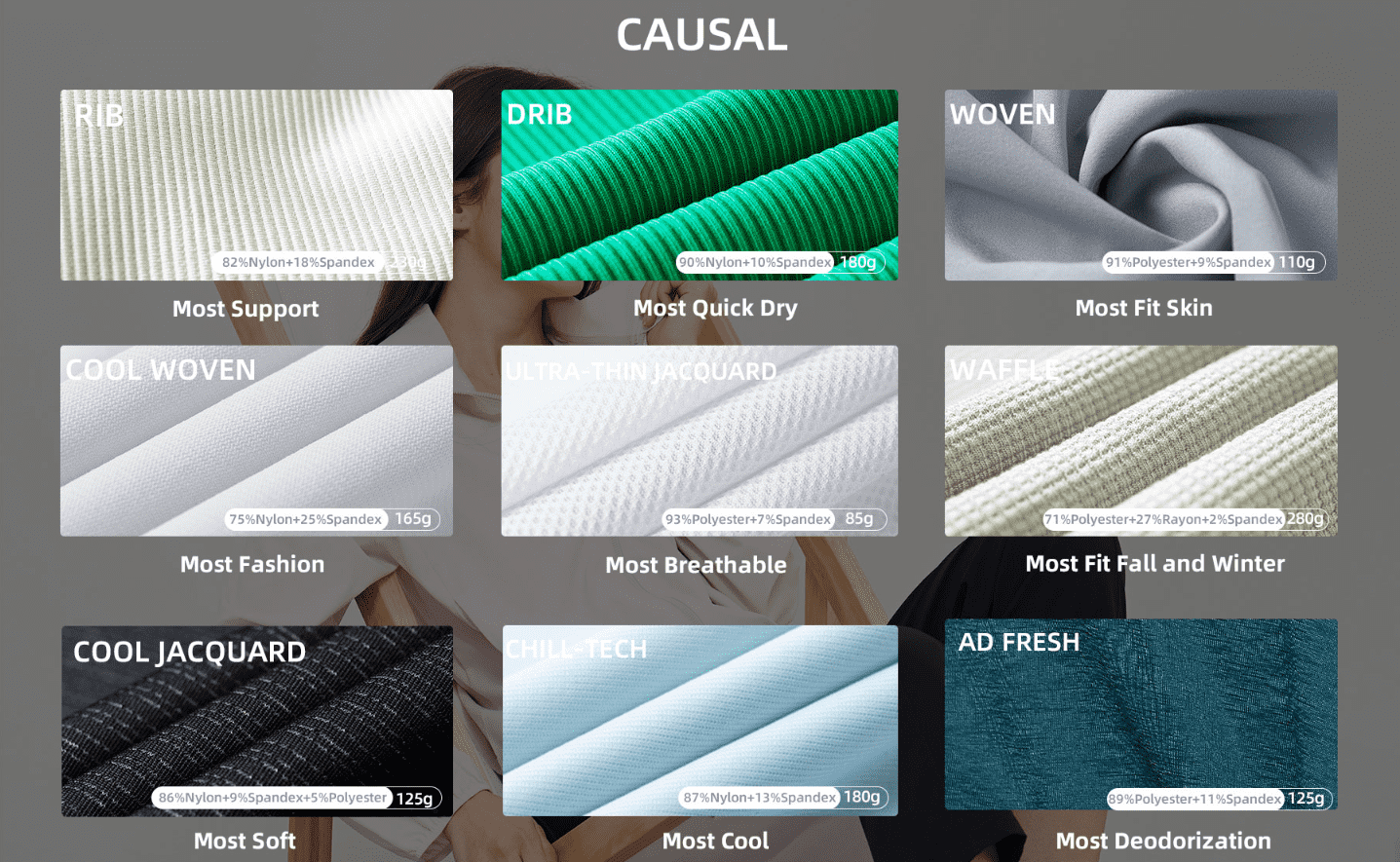
Some products have the same fabric and color as the main fabric and lining. However, printed and textured products use well-matched flat fabrics on the interior with similar quality and feel for ultimate comfort and fit. For more information please contact us.
The process of making fabric:





We strictly select fabrics and all fabrics undergo the following tests:
Resistance to soaping, friction, light, bleaching or oxidants (reducing agents), ironing resistance, perspiration resistance and perspiration-to-light color fastness, etc.

Color fastness to soap washing
1. Comparison of test methods for color fastness to soap washing
Color fastness to soap washing is one of the most common color fastness assessment items. Color fastness to soap washing refers to the degree of fading of colored fabrics after soap washing under specified conditions. It includes two evaluation contents: original fading and white cloth staining. Original fading refers to the fading of colored fabrics before and after soap washing; white cloth staining refers to the situation where white cloth and colored fabrics are sewn together in a certain way, and after soap washing, the white cloth is stained due to the fading of the colored fabric. The degree of fading or staining should be tested under a specified light source and rated with a standard gray card. The results are divided into 5 levels, with 5 being the best and 1 being the worst.
2. Relationship between dye structure, dyeing and post-treatment process and color fastness to soap washing
In daily testing, a considerable number of textiles, including cotton, wool, polyester, nylon and their blended fabrics, as well as spandex-containing elastic fabrics, have staining of nylon and acetate fiber linings at or below level 3. Although the dyes and printing and dyeing processes used for different fiber materials are different, the problems that arise are quite similar. This is mainly related to the floating color on the cloth surface and the transfer of some colored fiber particles, and is therefore related to the type of dye used, the dyeing process and the post-treatment process.
3. The color fastness of reactive dye dyed products to soaping is determined by the unfixed dyes
Take reactive dyes as an example. In theory, since the dyes form a covalent bond with the fibers, washing with water cannot easily cause dye desorption, fading and bleeding. Therefore, the color fastness of reactive dye dyed products to soaping is determined by the amount of unfixed dyes (hydrolyzed dyes and a small amount of unreacted dyes). If the hydrolyzed dyes are not completely removed by soaping, subsequent washing will cause continuous discoloration. The soaping fastness is also related to the bonding stability of the bonded dyes, and the broken bond dyes will also fade by washing. Therefore, the most important factors affecting the color fastness to soaping are the dye structure and properties, followed by dyeing and post-dyeing treatment processes. Reactive dyes have a high fixation rate, or a slow hydrolysis rate, a small amount of hydrolyzed dyes, and a small amount of dyes that need to be washed and removed. Unfixed dyes and hydrolyzed dyes have low directness, good water solubility, are not easy to stain, and are easy to wash off. However, if the dye concentration is high and the amount of residual dye is large, it is not easy to wash off.
Color fastness to rubbing
1. Comparison of test methods for color fastness to rubbing
The color fastness to rubbing test refers to a test in which a colored sample is rubbed with a dry rubbing cloth and a wet rubbing cloth respectively, and then the degree of staining of the rubbing cloth is evaluated. The test results are divided into 5 levels, with 5 being the best and 1 being the worst. Although the test process is simple, it is the most basic color fastness assessment indicator for textile products, and is almost one of the items that buyers from all countries must assess when placing orders. The technical conditions of the rubbing fastness test standards of various countries are very similar, but there are also some differences.
2. The main factors affecting color fastness to rubbing and their control measures
During the friction between textiles and other objects, the color shedding or the degree of staining on the rubbed object is affected by many factors.
There are two ways of color shedding and staining:
First, the dye on the textile falls off or fades, and stains on the surface of the rubbing object;
Second, the dyed fiber falls off and adheres to the surface of the rubbing object.
3. In practice, dye shedding is the main cause of staining. Although there are certain differences in the strength and adhesion of the covalent bonds formed between reactive dyes of different chemical structures and cellulose fibers, their effects on the wet rubbing color fastness of dyed fabrics are basically the same. When dyed fabrics are wet rubbed, the covalent bonds formed between the dye and the fiber will not break and produce floating color. The transferred dye usually does not form a covalent bond with the fiber, but only relies on van der Waals force to produce adsorption, that is, floating color.
Color fastness to light
1. Comparison of test methods for color fastness to light
The color fastness to light test refers to placing a textile sample together with a set of blue wool standard samples under artificial light and exposing them under specified conditions, and then comparing the color changes of the two to evaluate the color fastness.
2. Ways to improve color fastness to light
The light fading mechanism of dyes is very complicated, but it is mainly that the dyes are excited after absorbing photons, and a series of photochemical reactions occur to destroy the structure, resulting in discoloration and fading. The color fastness to light of textiles mainly depends on the chemical structure of the dye, as well as its aggregation state, combination state and mixed color matching. Therefore, it is very important to choose dyes reasonably.
3. Select dyes according to fiber properties and textile uses
For cellulose fiber textiles, dyes with good antioxidant properties should be selected; for protein fibers, dyes with good anti-reduction properties or containing weak oxidizing additives should be selected; for other fibers, dyes should be selected based on their effects on fading. In order to enhance the light-resistant oxidation stability of the azo group in the dye molecular structure, some strong electron-withdrawing groups are usually introduced at the ortho position of the azo group during the dye synthesis process, thereby reducing the electron cloud density of the azo hydrogen atom. In addition, hydroxyl groups can be introduced at the two ortho positions of the azo group to use their coordination ability to complex with heavy metals, thereby reducing the electron cloud density of the azo hydrogen atom and shielding the azo group, ultimately improving the light fastness of the dye.
4. Dyes should be selected according to color depth
A large number of experiments have shown that the light fastness of reactive dyes on cellulose fibers is proportional to the depth of the dye, that is, the darker the color, the better the light fastness. This is because the higher the concentration of the dye on the fiber, the greater the aggregation of the dye molecules, the smaller the surface area of the same amount of dye exposed to air, moisture and light, and the lower the probability of the dye being photo-oxidized. On the contrary, the lighter the color, the more highly dispersed the dye is on the fiber, and the higher the probability of being exposed to light, which ultimately significantly reduces the light fastness. Therefore, dyes with higher light fastness should be selected for dyeing light-colored varieties. In addition, many finishing agents such as softeners and anti-wrinkle finishing agents are added to the fabric, which will also reduce the light fastness of the product. Therefore, dyes that are insensitive to these finishing agents should be selected.
5. Dyes with good light stability and compatibility should be selected for color matching
Different dyes have different fading properties, and even different light fading mechanisms. Sometimes, the presence of one dye will sensitize the fading of another dye. When matching colors, dyes that will not sensitize each other and can even improve light stability should be selected. This is especially important when dyeing dark varieties such as black. If one of the three primary colors fades too quickly, it will quickly cause the dyed fiber or fabric to change color, and the faded dye residue will also affect the light stability of the other two dyes that have not faded. Reasonable control of the dyeing process, so that the dye and the fiber are fully combined, and try to avoid hydrolyzed dyes and unfixed dyes remaining on the fiber, is an important way to obtain higher light fastness.
Water/sweat color fastness
1. Comparison of test methods for water and sweat color fastness
Water color fastness reflects the self-discoloration and staining of textiles to adjacent fabrics under the combined action of certain moisture, pressure and temperature. During the test, after the sample and the adjacent fabric are fully soaked, they are placed in an oven at a certain temperature for a certain period of time under a certain pressure, taken out and dried, and the discoloration and staining levels are evaluated. The discoloration and staining levels are divided into 5 levels, with 5 being the best and 1 being the worst.
Perspiration color fastness reflects the self-discoloration and staining of textiles to adjacent fabrics under the combined action of pressure and temperature in different test solutions containing histidine. The discoloration of the sample and the staining of the adjacent fabric are evaluated with a gray card, and the results are divided into 5 levels, with 5 being the best and 1 being the worst.
2. Ways to improve water and sweat color fastness
The most important way to improve the water and sweat color fastness of fabrics is to select dyes reasonably, especially dyes with high fixation rate and good stability. Reasonable formulation and control of dyeing process, strengthening of color fixing conditions, and formation of highly stable covalent bonds can fully fix the dye. For example, when dyeing with dyes with poor reactivity, catalysts can be used, or appropriate color fixing agents can be selected, or color fixing can be performed at a higher temperature.
FAQ about Fabrics:
1. Can I choose the fabric for my custom yoga wear, either from what we currently have or custom-made?
Yes, we can customize the color and fabric composition to meet your needs.
2. Why is there a minimum order quantity for fabrics?
Different fabrics require different yarns and weaving methods, and it takes 0.5 hours to change the entire spandex and 1 hour to change the yarn, but after starting the machine, it can weave a piece of fabric within 3 hours.
3. How many pieces can a piece of cloth make?
The number of pieces varies depending on the style and size of the clothing.
4. Why is jacquard fabric expensive?
Jacquard fabric takes longer to weave than regular fabric, and the more complex the pattern, the more difficult it is to weave. A regular fabric can produce 8-12 rolls of fabric per day, while jacquard fabric takes longer to change yarns, which takes 2 hours, and adjusting the machine after changing the yarn takes half an hour.
5. What is the MOQ for jacquard fabric?
The MOQ for jacquard fabric is 500 kilograms or more. A roll of raw fabric is approximately 28 kilograms, which equates to 18 rolls, or approximately 10,800 pairs of pants.


